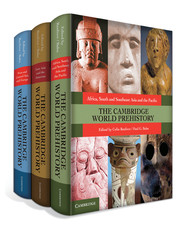Book contents
- Frontmatter
- Contents Summary for Volumes 1, 2 and 3
- Contents
- Volume 1 Maps
- Volume 2 Maps
- Volume 3 Maps
- About the Contributors
- Volume 1
- I. Introduction
- II. Africa
- 1.4 Early Hominins
- 1.5 Earliest Industries of Africa
- 1.6 The Human Revolution
- 1.7 The Genus Homo in Africa
- 1.8 Becoming Human: Archaeology of the Sub-Saharan Middle Stone Age
- 1.9 The Later Stone Age of Southern Africa
- 1.10 Prehistory in North Africa after the Middle Palaeolithic
- 1.11 Holocene Prehistory of West Africa
- 1.12 The Archaeology of the Central African Rainforest: Its Current State
- 1.13 The Later Prehistory of Southern Africa from the Early to the Late Iron Age
- 1.14 The Prehistory of East Africa
- 1.15 Neolithic and Predynastic Egypt
- 1.16 The Emergence of the Egyptian State
- 1.17 Pharaonic History
- 1.18 Summary of Classical and Post-Classical Africa
- 1.19 Africa: Languages
- III. South and Southeast Asia
- IV. The Pacific
- Volume 2
- Volume 3
- Index
- References
1.9 - The Later Stone Age of Southern Africa
from II. - Africa
Published online by Cambridge University Press: 05 August 2014
- Frontmatter
- Contents Summary for Volumes 1, 2 and 3
- Contents
- Volume 1 Maps
- Volume 2 Maps
- Volume 3 Maps
- About the Contributors
- Volume 1
- I. Introduction
- II. Africa
- 1.4 Early Hominins
- 1.5 Earliest Industries of Africa
- 1.6 The Human Revolution
- 1.7 The Genus Homo in Africa
- 1.8 Becoming Human: Archaeology of the Sub-Saharan Middle Stone Age
- 1.9 The Later Stone Age of Southern Africa
- 1.10 Prehistory in North Africa after the Middle Palaeolithic
- 1.11 Holocene Prehistory of West Africa
- 1.12 The Archaeology of the Central African Rainforest: Its Current State
- 1.13 The Later Prehistory of Southern Africa from the Early to the Late Iron Age
- 1.14 The Prehistory of East Africa
- 1.15 Neolithic and Predynastic Egypt
- 1.16 The Emergence of the Egyptian State
- 1.17 Pharaonic History
- 1.18 Summary of Classical and Post-Classical Africa
- 1.19 Africa: Languages
- III. South and Southeast Asia
- IV. The Pacific
- Volume 2
- Volume 3
- Index
- References
Summary
In this summary of the Later Stone Age (LSA) of southernmost Africa, I take a historical and thematic approach, sketching out the initial assumptions and ideas inherent in the generation of the term and following through with methodological and conceptual developments towards the present state of knowledge. I have assumed that such changes in approach by successive archaeologists add to our growing understanding of life in the Later Stone Age rather than replace erroneous versions with more reliable ones. Our current understanding is a composite of the insights gained from a variety of approaches, some theoretically motivated, some not. Despite these cumulative changes, some issues have remained alive through the decades.
Stone
The idea of a Later Stone Age (following an Earlier Stone Age [ESA] and Middle Stone Age [MSA]; see Chapters 1.5 and 1.8) grew out of a series of informal meetings and more formal conferences held across southern Africa in the 1920s. Some participants were amateurs. The professionals involved were, with the exception of John Goodwin, not primarily trained in archaeology but were either natural scientists and fieldworkers attached to museums or practising engineers. The visit of Goodwin’s Cambridge mentor Miles Burkitt to southern Africa in the late 1920s provided the final stimulus towards a regional synthesis (Burkitt 1928; Goodwin & van Riet Lowe 1929), one that remained influential for some time. As elsewhere in the world, the preoccupation then was with the chronological ordering of assemblages of stone tools without the advantage of any absolute dating methodology.
- Type
- Chapter
- Information
- The Cambridge World Prehistory , pp. 131 - 150Publisher: Cambridge University PressPrint publication year: 2014



